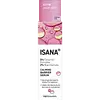What's inside
What's inside
 Key Ingredients
Key Ingredients

 Benefits
Benefits

 Concerns
Concerns

No concerns
 Ingredients Side-by-side
Ingredients Side-by-side

Water
Skin ConditioningGlycerin
HumectantOctyldodecanol
EmollientNiacinamide
SmoothingDistarch Phosphate
AbsorbentDicaprylyl Carbonate
EmollientXanthan Gum
EmulsifyingPectin
Emulsion StabilisingPhenoxyethanol
PreservativePanthenol
Skin ConditioningHydroxyacetophenone
AntioxidantDicaprylyl Ether
EmollientLauryl Alcohol
EmollientAllantoin
Skin ConditioningPentylene Glycol
Skin ConditioningChondrus Crispus Powder
AbrasiveMadecassoside
AntioxidantPhospholipids
Skin ConditioningCyanocobalamin
Skin ConditioningSphingolipids
EmollientSodium Citrate
BufferingP-Anisic Acid
MaskingSodium Hydroxide
BufferingTocopherol
AntioxidantWater, Glycerin, Octyldodecanol, Niacinamide, Distarch Phosphate, Dicaprylyl Carbonate, Xanthan Gum, Pectin, Phenoxyethanol, Panthenol, Hydroxyacetophenone, Dicaprylyl Ether, Lauryl Alcohol, Allantoin, Pentylene Glycol, Chondrus Crispus Powder, Madecassoside, Phospholipids, Cyanocobalamin, Sphingolipids, Sodium Citrate, P-Anisic Acid, Sodium Hydroxide, Tocopherol
Water
Skin ConditioningPropanediol
SolventDicaprylyl Carbonate
EmollientGlycerin
HumectantUndecane
EmollientCeramide Ng
Skin ConditioningTridecane
PerfumingGlycine Soja Seed Extract
Skin ConditioningCeramide NP
Skin ConditioningCeramide AP
Skin ConditioningCeramide As
Skin ConditioningCeramide Ns
Skin ConditioningCeramide EOP
Skin ConditioningGossypium Herbaceum Callus Culture
Skin ConditioningDimethicone
EmollientEctoin
Skin ConditioningAsiaticoside
AntioxidantMadecassic Acid
Skin ConditioningAsiatic Acid
Skin ConditioningSilica
AbrasiveHydrogenated Lecithin
EmulsifyingXanthan Gum
EmulsifyingSclerotium Gum
Emulsion StabilisingDipropylene Glycol
HumectantLecithin
EmollientDimethicone/Vinyl Dimethicone Crosspolymer
Skin ConditioningPullulan
Sucrose Distearate
EmollientGlyceryl Stearate
EmollientCholesterol
EmollientTocopherol
AntioxidantCitric Acid
BufferingAlcohol
AntimicrobialEthylhexylglycerin
Skin ConditioningPhenoxyethanol
PreservativeWater, Propanediol, Dicaprylyl Carbonate, Glycerin, Undecane, Ceramide Ng, Tridecane, Glycine Soja Seed Extract, Ceramide NP, Ceramide AP, Ceramide As, Ceramide Ns, Ceramide EOP, Gossypium Herbaceum Callus Culture, Dimethicone, Ectoin, Asiaticoside, Madecassic Acid, Asiatic Acid, Silica, Hydrogenated Lecithin, Xanthan Gum, Sclerotium Gum, Dipropylene Glycol, Lecithin, Dimethicone/Vinyl Dimethicone Crosspolymer, Pullulan, Sucrose Distearate, Glyceryl Stearate, Cholesterol, Tocopherol, Citric Acid, Alcohol, Ethylhexylglycerin, Phenoxyethanol
 Reviews
Reviews

Ingredients Explained
These ingredients are found in both products.
Ingredients higher up in an ingredient list are typically present in a larger amount.
Dicaprylyl Carbonate comes from carbonic acid and caprylyl alcohol, a fatty alcohol. It is an emollient and gives skin a velvet feel. The sources of Dicaprylyl Carbonate may be synthetic or from animals.
As an emollient, Dicaprylyl Carbonate creates a film on the skin. This film traps moisture in, keeping your skin soft and hydrated.
Glycerin is already naturally found in your skin. It helps moisturize and protect your skin.
A study from 2016 found glycerin to be more effective as a humectant than AHAs and hyaluronic acid.
As a humectant, it helps the skin stay hydrated by pulling moisture to your skin. The low molecular weight of glycerin allows it to pull moisture into the deeper layers of your skin.
Hydrated skin improves your skin barrier; Your skin barrier helps protect against irritants and bacteria.
Glycerin has also been found to have antimicrobial and antiviral properties. Due to these properties, glycerin is often used in wound and burn treatments.
In cosmetics, glycerin is usually derived from plants such as soybean or palm. However, it can also be sourced from animals, such as tallow or animal fat.
This ingredient is organic, colorless, odorless, and non-toxic.
Glycerin is the name for this ingredient in American English. British English uses Glycerol/Glycerine.
Learn more about GlycerinPhenoxyethanol is a preservative that has germicide, antimicrobial, and aromatic properties. Studies show that phenoxyethanol can prevent microbial growth. By itself, it has a scent that is similar to that of a rose.
It's often used in formulations along with Caprylyl Glycol to preserve the shelf life of products.
Tocopherol (also known as Vitamin E) is a common antioxidant used to help protect the skin from free-radicals and strengthen the skin barrier. It's also fat soluble - this means our skin is great at absorbing it.
Vitamin E also helps keep your natural skin lipids healthy. Your lipid skin barrier naturally consists of lipids, ceramides, and fatty acids. Vitamin E offers extra protection for your skin’s lipid barrier, keeping your skin healthy and nourished.
Another benefit is a bit of UV protection. Vitamin E helps reduce the damage caused by UVB rays. (It should not replace your sunscreen). Combining it with Vitamin C can decrease sunburned cells and hyperpigmentation after UV exposure.
You might have noticed Vitamin E + C often paired together. This is because it is great at stabilizing Vitamin C. Using the two together helps increase the effectiveness of both ingredients.
There are often claims that Vitamin E can reduce/prevent scarring, but these claims haven't been confirmed by scientific research.
Learn more about TocopherolWater. It's the most common cosmetic ingredient of all. You'll usually see it at the top of ingredient lists, meaning that it makes up the largest part of the product.
So why is it so popular? Water most often acts as a solvent - this means that it helps dissolve other ingredients into the formulation.
You'll also recognize water as that liquid we all need to stay alive. If you see this, drink a glass of water. Stay hydrated!
Learn more about WaterXanthan gum is used as a stabilizer and thickener within cosmetic products. It helps give products a sticky, thick feeling - preventing them from being too runny.
On the technical side of things, xanthan gum is a polysaccharide - a combination consisting of multiple sugar molecules bonded together.
Xanthan gum is a pretty common and great ingredient. It is a natural, non-toxic, non-irritating ingredient that is also commonly used in food products.
Learn more about Xanthan Gum